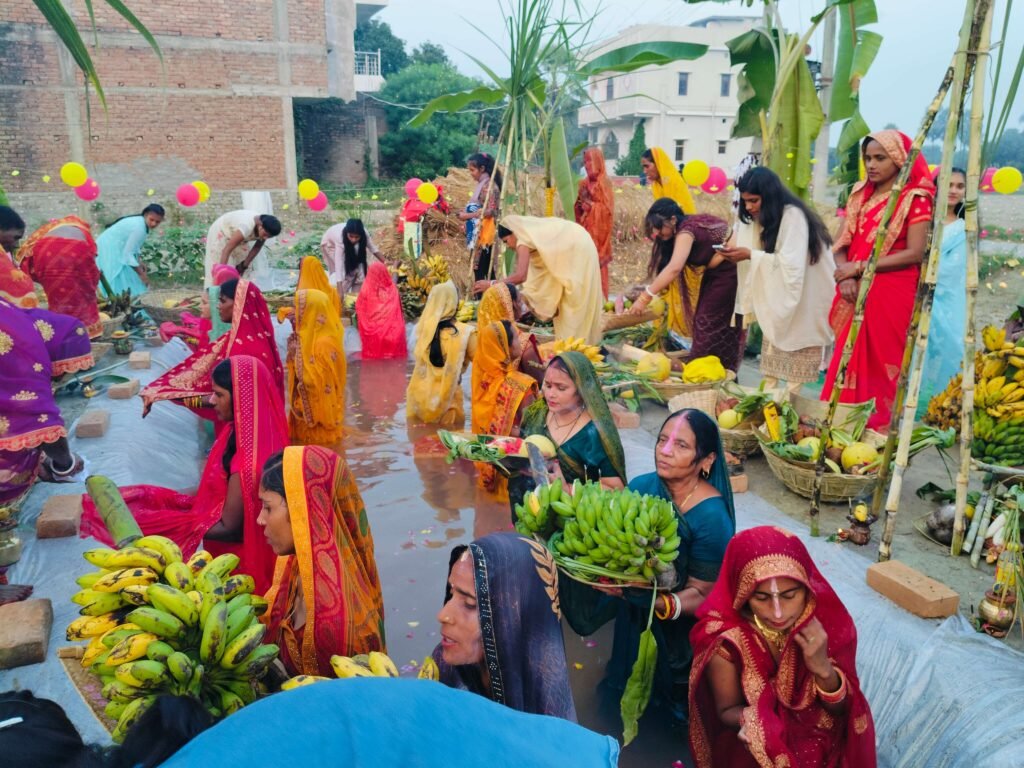How Chhath Puja is Celebrated in Bihar
Chhath Puja is one of the most sacred and ancient Hindu festivals dedicated to the Sun
God (Surya Dev) and Chhathi Maiya.
It is mainly celebrated in the Indian states of Bihar, Jharkhand, Eastern Uttar Pradesh, and
Nepal’s Terai region.
The festival expresses gratitude to the Sun for sustaining life on Earth and seeks blessings for prosperity, health, and happiness.
Chhath Puja is a four-day ritual filled with strict discipline, fasting, cleanliness, and devotion.

Chhath Puja Daily Rituals
Day 1 – Naha Khaye
The first day marks the beginning of purity and preparation for the festival. The house and surroundings are cleaned thoroughly to maintain sanctity.
The devotees (mainly women called Vrati) eat only once on this day — a simple and pure meal cooked with utmost cleanliness, often including lauki (bottle gourd) and rice cooked in bronze utensils using river water and cow dung fire.
Day 2 – Kharna
The second day is the day of fasting and self-discipline. The Vrati observes a strict fast for the whole day, without even a sip of water.
In the evening, after worshiping the Sun God, they prepare Kheer (sweet rice pudding made with jaggery and milk), Roti (chapati), and bananas as Prasad (holy offering). After offering the Prasad to the Sun, the devotee breaks the fast — this is called Kharna.
Day 3 – Sandhya Arghya
This is the main and most beautiful day of the Chhath Puja. Significance: The setting Sun symbolizes the completion of life’s cycle and teaches the importance of gratitude and humility.
Devotees and their families prepare Soops (Bamboo Baskets) filled with Thekua, fruits
(banana, sugarcane, coconut), and other offerings.
In the evening, devotees, dressed in traditional attire, go to the riverbank or ghat. The atmosphere is filled with devotion, folk songs, and prayers.
Standing in the water, they offer Arghya (offering) to the setting Sun with folded hands, thanking him for sustaining life on Earth. Devotees sing Chhath Geet (folk songs) and pray for the well-being of their family, health, and happiness.
Day 4 – Usha Arghya
The final day of Chhath Puja marks the offering to the rising Sun, symbolizing new beginnings and hope. Devotees reach the ghats before sunrise, carrying the same soops filled with offerings.
As the Sun rises, they offer Arghya to the rising Sun (Usha Arghya) and pray for peace, prosperity, and longevity of family members.
After this, the devotees break their 36-hour-long fast by eating Prasad, marking the end of Chhath Puja.
Family members touch the feet of the Vrati to receive blessings, and the atmosphere fills with happiness and gratitude.
